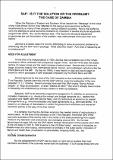| dc.contributor.author | Jesuit Centre for Theological Reflection | |
| dc.date.accessioned | 2023-05-03T07:19:26Z | |
| dc.date.available | 2023-05-03T07:19:26Z | |
| dc.date.issued | 1997-01-30 | |
| dc.identifier.uri | https://hdl.handle.net/20.500.14274/1781 | |
| dc.description | At the time of its Independence in 1964, Zambia was considered one of the richest countries in Africa, endowed with prosperous copper mines. But the 1970s saw the drastic decline of copper prices and the rapid increase of petrol prices. Zambia was hit hard and began to borrow heavily from international banks, donors, and multilateral institutions like the World Bank and the IMF, By the mid 1980s, it was heavily in debt and had to begin to submit to reform packages of SAP proposed (imposed!) by the World Bank and IMF. | en |
| dc.description.abstract | When the Bishops of Eastern and Southern Africa issued their "Message" at the close of the 1994 African Synod, they reflected on the serious sociology-economic suffering experienced by so many of their people in various different countries. Key to that suffering were the attempts to solve economic problems by imposition of severe structural adjustment programmes (SAP). But, as the Bishops said, "The economic structural adjustment programmes are not the solution of the problem; they make people more poor than ever before. | en |
| dc.description.sponsorship | Irish Aid and Joint Country Programme | en |
| dc.language.iso | en | en |
| dc.publisher | Jesuit Centre for Theological Reflection | en |
| dc.rights | Attribution-ShareAlike 3.0 United States | * |
| dc.rights.uri | http://creativecommons.org/licenses/by-sa/3.0/us/ | * |
| dc.subject | January 1997 | en |
| dc.subject | Case Study | en |
| dc.subject | Cost of Living | en |
| dc.subject | SAP | en |
| dc.title | January 1997 Bulletin: SAP: Is it the Solution or the Problem? the Case Study of Zambia | en |
| dc.type | Case Study | en |

